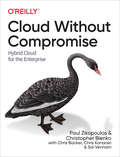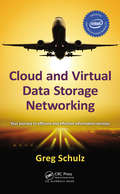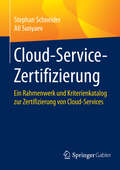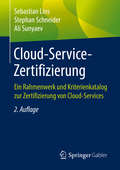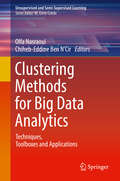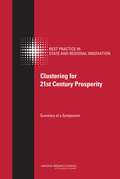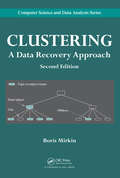- Table View
- List View
Cloud Without Compromise: Hybrid Cloud for the Enterprise
by Paul Zikopoulos Christopher Bienko Chris Backer Chris Konarski Sai VennamMany companies claim to have "gone to the cloud," yet returns from their efforts are meager or worse. Why? Because they've defined cloud as a destination, not a capability. Using cloud as a single-vendor, one-stop destination is fiction; in practice, today's organizations use a mosaic of capabilities across several vendors. Your cloud strategy needs to follow a hybrid multicloud model, one that delivers cloud's value at destinations you choose.This practical guide provides business leaders and C-level executives with guidance and insights across a wide range of cloud-related topics, such as distributed cloud, microservices, and other open source solutions for strengthening operations. You'll apply in-the-field best practices and lessons learned as you define your hybrid cloud strategy and drive your company's transformation strategy.Learn cloud fundamentals and patterns, including basic concepts and historyGet a framework for cloud acumen phases to value-plot your cloud futureKnow which questions to ask a cloud provider before you signDiscover potential pitfalls for everything from the true cost of a cloud solution to adopting open source the right way
Cloud and Virtual Data Storage Networking
by Greg SchulzThe amount of data being generated, processed, and stored has reached unprecedented levels. Even during the recent economic crisis, there has been no slow down or information recession. Instead, the need to process, move, and store data has only increased. Consequently, IT organizations are looking to do more with what they have while supporting gr
Cloud-Based Cyber-Physical Systems in Manufacturing
by Lihui Wang Xi Vincent WangThis book presents state-of-the-art research, challenges and solutions in the area of cloud-based cyber-physical systems (CPS) used in manufacturing. It provides a comprehensive review of the literature and an in-depth treatment of novel methodologies, algorithms and systems in the area of architecture design, cyber security, process planning, monitoring and control. The book features detailed descriptions of how to derive solutions in a cloud environment where physical machines can be supported by cyber decision systems when engaged in real operations. It presents a range of novel ideas and is characterized by a balanced approach in terms of scope vs. depth and theory vs. applications. It also takes into account the need to present intellectual challenges while appealing to a broad readership, including academic researchers, practicing engineers and managers, and graduate students. Dedicated to the topic of cloud-based CPS and its practical applications in manufacturing, this book benefits readers from all manufacturing sectors, from system design to lifecycle engineering and from process planning to machine control. It also helps readers to understand the present challenges and future research directions towards factories of the future, helping them to position themselves strategically for career development.
Cloud-Service-Zertifizierung: Ein Rahmenwerk und Kriterienkatalog zur Zertifizierung von Cloud-Services
by Stephan Schneider Ali SunyaevDie Auslagerung von Services in die Cloud ist mit Risiken verbunden. Dieses Buch liefert ein Rahmenwerk zur Zertifizierung von Services in der Cloud. Herzstück dabei ist ein umfangreicher Kriterienkatalog zum Assessment von Cloud-Services. Dabei wendet sich das Buch an Cloud-Service-Anwender und unterstützt bei der Bewertung, dem Vergleich und der Auswahl von Angeboten. Gerade in kritischen Bereichen wie Sicherheit, Verfügbarkeit und Vertragsfragen unterstützt der Katalog bei der Definition von eigenen Anforderungen. Das Buch eignet sich jedoch auch für Cloud-Service-Anbieter, die es zum Self-Assessment und zur Verbesserung der eigenen Services nutzen können. Das Buch fasst eines der Ergebnisse des dreijährigen Forschungsprojekts ,,Value4Cloud" zusammen, das im Rahmen des Technologieprogramms ,,Trusted Cloud" vom Bundesministerium für Wirtschaft und Technologie gefördert wurde. Es liefert mit 219 Zertifizierungskriterien und einem Zertifizierungsrahmenwerk einen wichtigen Beitrag zum Assessment von Cloud-Services und der Verbesserung von Cloud-Service-Zertifizierungen.
Cloud-Service-Zertifizierung: Ein Rahmenwerk und Kriterienkatalog zur Zertifizierung von Cloud-Services
by Stephan Schneider Ali Sunyaev Sebastian LinsDieses Buch liefert ein Rahmenwerk zur Zertifizierung von Services in der Cloud. Herzstück dabei ist ein umfangreicher Kriterienkatalog zum Assessment von Cloud-Services, der im Forschungsprojekt „Value4Cloud“ , gefördert vom Bundesministerium für Wirtschaft und Technologie, entwickelt wurde. Cloud-Service-Anwender werden bei der Bewertung, dem Vergleich und der Auswahl von Services unterstützt. Das Buch eignet sich auch für Cloud-Service-Anbieter zum Self-Assessment und zur Verbesserung der eigenen Services.
Cloud-Transformation: Wie die Public Cloud Unternehmen verändert
by Roland Frank Gregor Schumacher Andreas TammIn diesem Buch lernen Sie, wie die Public Cloud die Kostenstrukturen von digitalen Geschäftsmodellen und damit bestehende Märkte signifikant verändert. Die Zusammenhänge zwischen den verwendeten Cloud-Architekturen, der Organisation des Unternehmens und den dadurch möglichen Preis- und Geschäftsmodellen werden übersichtlich und für den Einsatz im eigenen Unternehmen nutzbar aufbereitet.Die Autoren erläutern, wie der Reihe nach immer mehr Märkte zu digitalen Märkten werden und welche Rolle die Grenzkosten dabei spielen. Sie beschreiben, wie die cloudbasierte IT die klassische IT disruptiert. Dadurch können kleine Teams mit geringen Investitionen weltweit skalierende Geschäftsmodelle zu Null-Grenzkosten aufbauen. Die wirtschaftlichen Effekte werden anhand konkreter Beispiele nachvollziehbar dargestellt. Zusätzlich erhalten technische Laien einen Überblick, welche Faktoren für die Wettbewerbsfähigkeit ihrer digitalen Geschäftsmodelle besonders wichtig sind und wie Manager diese beeinflussen können. Zum Abschluss gibt das Buch Praktikern einen konkreten Leitfaden an die Hand, wie die Cloud-Transformation im Unternehmen durchgeführt werden kann. Das Buch richtet sich vor allem an Führungskräfte und Mitarbeiter in den Fachbereichen und der IT, die die Cloud-Transformation in ihren Unternehmen vorantreiben möchten.
CloudFlare, Inc.: Running Hot?
by Thomas R. Eisenmann Alex GoddenIn July 2012, the cofounders of CloudFlare, a Silicon Valley startup that protects websites and accelerates their traffic, are considering the implications of five employees' resignations over the prior three months. Was this natural attrition for a high-tech venture with a staff of 35 experiencing explosive growth, or were the resignations symptomatic of bigger issues with CloudFlare's culture and management processes? After describing CloudFlare's early history, business model, organization structure, and human resources policies, the case presents first-person accounts from employees regarding their reasons for resigning, and then asks whether CloudFlare's cofounders should take any corrective actions.
Cloudmoney: Cash, Cards, Crypto, and the War for Our Wallets
by Brett ScottThe reach of Corporations into our lives via cards and apps has never been greater; many of us rarely use cash these days. But what we’re told is a natural and inevitable move is actually the work of powerful interests. And the great battle of our time is the battle for ownership of the digital footprints that make up our lives.In Cloudmoney, Brett Scott tells an urgent and revelatory story about how the fusion of Big Finance and Big Tech requires “cloudmoney”—digital money underpinned by the banking sector—to replace physical cash. He dives beneath the surface of the global financial system to uncover a long-established lobbying infrastructure: an alliance of partners waging a covert war on cash. He explains the technical, political, and cultural differences between our various forms of money and shows how the cash system has been under attack for decades, as banking and tech companies promote a cashless society under the banner of progress.Cloudmoney takes us to the front lines of a war for our wallets that is also about our freedom, from marketing strategies against cash to the weaponization of COVID-19 to push fintech platforms, and from there to the rise of the cryptocurrency rebels and fringe groups pushing back. It asks the most pressing questions:Who benefits from a cashless society and who gets left behind?Is the end of cash the end of true privacy?And is our cloudmoney future closer than we think it is?
Cloudmoney: Efectivo, tarjetas, criptomonedas y la lucha por nuestras carteras
by Brett Scott¿Quién se beneficia de una sociedad sin efectivo? ¿Es el fin del dinero físico el fin de la verdadera privacidad? ¿El monopolio de las criptomonedas está más cerca de lo que pensamos? Hoy en día, muchos de nosotros apenas utilizamos dinero en efectivo y lo pagamos casi todo con tarjetas de crédito o aplicaciones del móvil. Es decir, con dinero digital. Sin embargo, lo que a todos nos parece cómodo, natural e inevitable resulta ser, fundamentalmente, el producto de poderosos intereses y manipulaciones. Cloudmoney es la enloquecedora crónica de este cambio de paradigma. Brett Scott ha buceado bajo la superficie del sistema financiero global para mostrarnos cómo las altas finanzas y las grandes compañías tecnológicas se han aliado con el objetivo de remplazar el dinero físico por el dinero digital, supuestamente en pro de una escurridiza visión de progreso, y cómo ese proceso no es más que una guerra encubierta por nuestros bolsillos y, en última instancia, por nuestra libertad. ¿Es de verdad preferible una sociedad sin efectivo, o supone el fin del dinero físico el fin de la verdadera privacidad? Ese futuro sin metálico, ¿está más cerca de lo que pensamos o aún hay tiempo para cambiar el rumbo? Un libro fundamental para entender qué es el dinero, en qué puede llegar a convertirse y cómo podemos salvarnos de las garras de las poderosas fintech. La crítica ha dicho:«Un texto maravillosamente revolucionario».Yanis Varoufakis «Te han llenado la cabeza con falsedades y confusión sobre el dinero. Este libro sobresaliente te ayudará a entender cómo ha sucedido, quién se beneficia de nuestra ignorancia financiera colectiva y cuál es la mejor manera de contratacar».Raj Patel, autor de Obesos y famélicos «En un libro que es a la vez irreverente, contundente y entretenido, Brett Scott hace añicos los mitos convencionales sobre el dinero en efectivo, el dinero digital y las criptomonedas».Stephanie Kelton, autora de El mito del déficit «Cloudmoney es un libro brillante, fascinante y totalmente accesible: una guía pionera y política de la red de finanzas globales en rápida evolución. Combinando la visión antropológica con la perspicacia financiera de un experto en elsector, Brett Scott expone una visión a largo plazo de cómo la tecnología y las finanzas se están fusionando rápidamente para potenciar el capitalismo corporativo».Kate Raworth, autora de Economía rosquilla «Con este maravilloso, lúcido e importante libro, Brett Scott apunta alto. Compra un ejemplar y asegúrate de pagar en efectivo».Nicholas Shaxson, autor de Las islas del tesoro «Una importante reflexión sobre el nuevo mundo de las finanzas».Lionel Barber, The Financial Times «La carrera hacia una sociedad sin efectivo no tiene nada que ver con la comodidad. Se trata de poder. Brett Scott se desmarca del relato oficial con esta inteligente crítica al dinero digital y al auge de los imperios de la tecnología financiera, al tiempo que ofrece una convincente visión alternativa. No te pierdas este libro».Jason Hickel, autor de Less is More
Clout
by Eric BollandThere is one major factor that explains business actions that has thus far escaped thorough exploration. That factor is clout, or as it is more broadly understood, power. Those with clout in the business organizations make the decisions and influence what the business does. Yet the origins and uses of clout are hidden. Everyone wants to know more about this inner world as clout is still largely unrecognized in studies of corporate culture. With Clout, the first researched-based book on the topic, Bolland fills this void. He systematically analyses the subject and answers the many questions about this aspect of business life, including exploring what organization clout is, how it has evolved, how it is manifested, how it is used and how it relates to other aspects of business organizations. Readers will be able to apply findings to their own career, and students will gain a tested framework for understanding the importance of this subject.
Clover Food Lab in 2016
by Lena G. Goldberg Sandra Bahous Sonia SmithAyr Muir, founder and CEO of Clover Food Lab, has grown his restaurant chain from a single food truck to 11 thriving stores but he has no interest in running a regional chain. His ambition is to change the way America eats and his goal is national expansion. As he surveys the competitive landscape and the forces shaping the restaurant industry in 2016, however, he must decide whether to pause the company's planned expansion beyond the greater Boston area and pursue other opportunities for growth or continue to expand Clover's geographic footprint.
Club Atletico Boca Juniors
by Anita Elberse Gustavo A. Herrero Alberto BallveClub Atletico Boca Juniors is the most popular soccer club in Argentina and one of the most decorated clubs in the world. Throughout its storied history, the club has recruited and developed dozens of star players. In his eleven years at Boca Juniors, president Mauricio Macri has significantly increased the club's net worth and annual revenues. However, he faces a constant challenge to remain competitive on and off the field. In November 2006, Macri is approached by Spanish and Italian soccer powerhouses, seeking to purchase the players Fernando Gago and Rodrigo Palacio. Should Macri enter negotiations with the clubs interested in buying the star players? If so, how should they approach the talks? Allows for an in-depth examination of Boca Junior's business model, and how it differs from that of the richer soccer clubs in Western Europe. Also enables an assessment of successful talent and brand management strategies in the context of a sports franchise with a worldwide reach.
Club College
by Andrew S RosenClub College is a chapter excerpt from Change.edu coming out October 18, 2011.On college campuses nationwide, luxury and learning go hand-in-hand, keeping the price tag for higher education out of reach for many Americans. Education innovator, and chairman and CEO of Kaplan, Inc., Andrew S. Rosen examines today's resort-style campus, providing inspiring solutions for stopping the spending spirals and making college affordable for all. Despite the financial crunch, many American universities have become surprisingly lavish over the past decade, providing state-of-the-art recreation facilities, bistro-style dining, spectacular residence halls that rival fine hotels, and "free" amenities such as Kindles, not to mention multi-million-dollar stadiums and coaches' salaries starting in the high six figures. Showcasing these extraordinary campuses, "Club College" captures the new economic models of higher education, which often divert funds from academics to gain a competitive edge in attracting an elite group of students. On this fascinating tour, Andrew S. Rosen proposes bold new alternatives that focus our nation's dollars on learning.Poised to spark a dialogue about our nation's higher education system, "Club College" makes the classroom the centerpiece of college once again, opening doors to careers for a broad range of talented individuals--arguably our greatest economic asset.
Club Management Issues in Australia and North America
by Clayton W. Barrows Nerilee HingDiscover the unique challenges confronting the club industryAs a distinctive sector of the hospitality industry, private clubs have their own unique set of challenges. Club Management Issues in Australia and North America provides a one-of-a-kind exploration of the membership, human resource, and other key management issues of the niche industry of private clubs-on two very different continents. This book closely examines the latest research to provide scholars and practitioners with a clear picture of the economic and social implications springing from the growth of the diverse private club industry while offering cogent discussions on effective management strategies.The impact of economic downturns affects all sectors of the hospitality market, including the private club industry. Club Management Issues in Australia and North America illustrates the trends now seen in the club industry in two major world markets. The book examines the declining membership issues in the United States and presents thoughtful consideration of member recruitment strategies. Australia&’s marked differences in private clubs are comprehensively explained, with a clear focus on the gaming aspect present there. An overview of the history of the club industry in Australia is presented, with emphasis on gaming machine operations and the positive and negative social and economic impact gambling has on the country. A thematic review of club management issues from years past gives readers a clearer understanding of where the industry is today and what areas need more empirical research. Employment relations are discussed in detail. A comparative analysis is also presented of the various challenges faced by clubs competing with one another. Legislative restrictions of advertising and marketing are explored, along with crucial membership and patronage issues.The book provides: research on changes in memberships in clubs in the United States a study on declining waiting lists at clubs characteristics club managers look for in job applicants differences in equity and non-equity membership structures an overview of the history of machine gambling in New South Wales analyses of past issues of taxation legislation, employment relations, social issues, innovation, and others-and the need for further empirical study how regulatory changes impact wage determination the effects of legislation restrictions on gaming advertising, promotion, and external signage analysis of the impact of clubs&’ involvement with special events consumer behavior in the club industry a case study of a club&’s failed attempt to tap into the youth marketClub Management Issues in Australia and North America is timely, informative reading for hospitality educators and students, hospitality professionals, and hospitality companies doing research in the private club industry.
Club Med (A)
by Christopher W.L. Hart Dan Maher Dan ArczynskiThe rapidly growing American subsidiary of an international resort company seeks to identify the factors underlying its success. The case describes the forces that shape the industry's structure, raising the issue of where it is possible for Club Med to establish a sustainable competitive advantage. Classic sources of competitive advantage are dealt with, leading to the role of corporate culture in creating a sustainable competitive advantage. The case also focuses on service quality from the standpoint of customer dissatisfaction and its associated costs.
Club Med (B)
by Christopher W.L. Hart Dan MaherHighlights the issue of high employee turnover in a multi-site, international subsidiary of a large resort company. Also described are service-quality problems the company has because the amount of value added through employee interaction with customers is high. Analysis of recruiting and hiring as a process flow is required to analyze the situation. There is also a cross-cultural issue due to a structural imbalance in the ratio of non-American (primarily French) managers to American managers.
Cluster Dynamics in Transition Economies: The Case of Albania (SpringerBriefs in Geography)
by Elona KarafiliThis book analyses the effectiveness of policies adopted in cluster promotion, using complexity thinking and evolutionary economic geography approaches. It studies cluster dynamics in transition economies, exploring the case of Albania.In developing countries, the ‘model’ of the developed countries, is often seen as the endpoint of a trajectory that must be followed meticulously, implying a view on modernization as a linear and uniform process. They tend to import policies from these ‘success models’ showing minimal regard to their context and institutional capabilities; therefore, more often than not, such policies show little effectiveness.This research on cluster policies in Albania confirms this. It suggests that in Albania there is a need to revise the way of thinking about clusters, considering them first and foremost as relational networks, instead of physically bound industrial districts.While there is questioning of top-down policies and the national innovation systems prerogative, the suggested model by this research, in line with some of the most recent policy frameworks, advocates the need for flexibility, bottom-up initiatives and place-based approaches.By means of conclusion, the book comes up with an alternative model of territorial policies for cluster development, shifting from ‘static’ towards ‘dynamic’ planning.
Cluster Mobilization in Mitteldeutschland
by Jeffrey Fear Christian H.M. Ketels Claudia LinsenmeierAs part of the privatization in Eastern Germany after the fall of the Berlin Wall, Dow Chemical made a major investment in the Halle-Leipzig region, one of the largest chemical industry sites in Europe. The executive in charge of Dow's operations in the region, Bart Groot, increasingly felt that the long-term success of Dow's investment depended on a more dynamic development of the entire regional economy. On his own initiative, in 1997, Groot launched a private sector-driven effort to enhance the economic development in central Germany, the region located around Halle-Leipzig. Bundling together 50 other firms and four cities, he founded a regional marketing effort to brand or market the area, but then shifted focus to building clusters. Examines the motivations of companies and company executives to get involved in regional competitiveness efforts and provides a platform to discuss the factors that drive the success of cluster-building efforts through cooperation across firms in a disadvantaged area.
Cluster-Based Industrial Development
by Keijiro Otsuka Tetsushi SonobeIn order to reduce widespread poverty in developing countries, it is essential to create jobs by promoting industrial development. Yet, there is no clear-cut and effective strategy to develop industries. This study tackles the problems facing cluster-based industrial development and suggests effective strategies for a more successful future. Based on a number of case studies and the results of six Kaizen management training experiments, this book has found that efficient management is the key to the innovation, which, in turn, is a major engine of firm and industrial growth. The studies undertaken reveal that management training not only enhances management capacity of entrepreneurs but also serves as an effective screening device to identify promising and non-promising entrepreneurs, which enables targeted policies to support the former. KAIZEN management is found to be effective in improving production management and quality control in several countries in SSA, which supports the authors' view that the management training is an integral part of the effective industrial development strategy. This book is essential reading for scholars and researchers interested in economic development and industrial policy.
Cluster-Based Industrial Development: A Comparative Study of Asia and Africa
by Keijiro Otsuka Tetsushi SonobeThis book examines how to promote industrial development in low-income countries. It considers the role of traders in the evolution of a cluster, the role of managerial human capital, the effect of the 'China shock', and the role of industrial policies focused on international knowledge transfer in supporting the upgrading of clusters.
Clustering Customers at Chateau
by Srikant M. Datar Caitlin N. BowlerThis case was written for the EC course “Managing with Data Science.” The course provides MBA students with no programming experience an introduction to the field of data science and its applications in business. Students learn to (1) carefully articulate the business ask; (2) reason carefully from the ask, through metrics and models and outputs; and (3) evaluate outputs from models to (4) develop a plan for action. In this case students explore data through k-means clustering, evaluate the relevance of those clusters to a marketing question, and compare the difference between k-means and Gaussian mixture models. They also learn the value of collaborative filtering for predicting customer preferences.
Clustering Methods for Big Data Analytics: Techniques, Toolboxes and Applications (Unsupervised and Semi-Supervised Learning)
by Olfa Nasraoui Chiheb-Eddine Ben N'CirThis book highlights the state of the art and recent advances in Big Data clustering methods and their innovative applications in contemporary AI-driven systems. The book chapters discuss Deep Learning for Clustering, Blockchain data clustering, Cybersecurity applications such as insider threat detection, scalable distributed clustering methods for massive volumes of data; clustering Big Data Streams such as streams generated by the confluence of Internet of Things, digital and mobile health, human-robot interaction, and social networks; Spark-based Big Data clustering using Particle Swarm Optimization; and Tensor-based clustering for Web graphs, sensor streams, and social networks. The chapters in the book include a balanced coverage of big data clustering theory, methods, tools, frameworks, applications, representation, visualization, and clustering validation.
Clustering for 21st Century Prosperity: Summary of a Symposium
by Charles W. WessnerResponding to the challenges of fostering regional growth and employment in an increasingly competitive global economy, many U. S. states and regions have developed programs to attract and grow companies as well as attract the talent and resources necessary to develop regional innovation clusters. These state and regionally based initiatives have a broad range of goals and increasingly include larger resources commitments, often with a sectoral focus and often in partnership with foundations and universities. Recent studies, however, have pointed out that many of these efforts lack the scale and the steady commitment needed for success. This has prompted new initiatives to coordinate and concentrate investments from a variety of federal agencies to develop research parks, business incubators, and other strategies to encourage entrepreneurships and high-tech development in the nation's regions. Understanding the nature of innovation clusters and public policies associated with successful cluster development is therefore of current relevance. Clustering for 21st Century Prosperity identifies best practices with regard to goals, structures, instruments, modes of operation, synergies across private and public programs, funding mechanisms and levels, and evaluation efforts. The committee, under the Board on Science, Technology, and Economic Policy (STEP) is reviewing selected state and regional efforts to capitalize on federal and state investments in areas of critical national needs. This review includes both efforts to strengthen existing industries as well as specific technology focus areas such as nanotechnology, stem cells, and advanced energy in order to better understand program goals, challenges, and accomplishments. As part of this study, the committee is convening a series of public workshops and symposia involving responsible local, state, and federal officials and other stakeholders. Drawing from discussions at these symposia, fact-finding meetings, and commissioned analyses of existing state and regional programs and technology focus areas, the committee will subsequently produce a final report with findings and recommendations focused on lessons, issues, and opportunities for complementary U. S. policies created by these state and regional initiatives.
Clustering: A Data Recovery Approach, Second Edition
by Boris MirkinOften considered more of an art than a science, books on clustering have been dominated by learning through example with techniques chosen almost through trial and error. Even the two most popular, and most related, clustering methods-K-Means for partitioning and Ward's method for hierarchical clustering-have lacked the theoretical underpinning req
